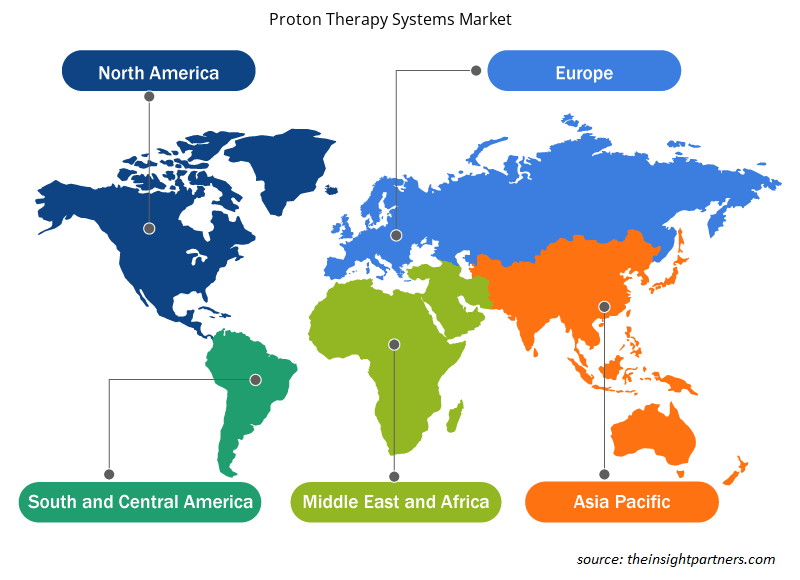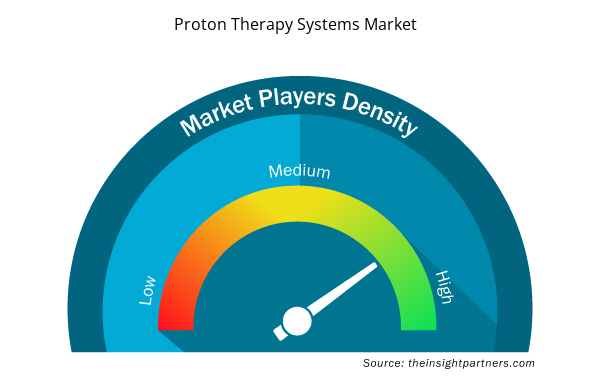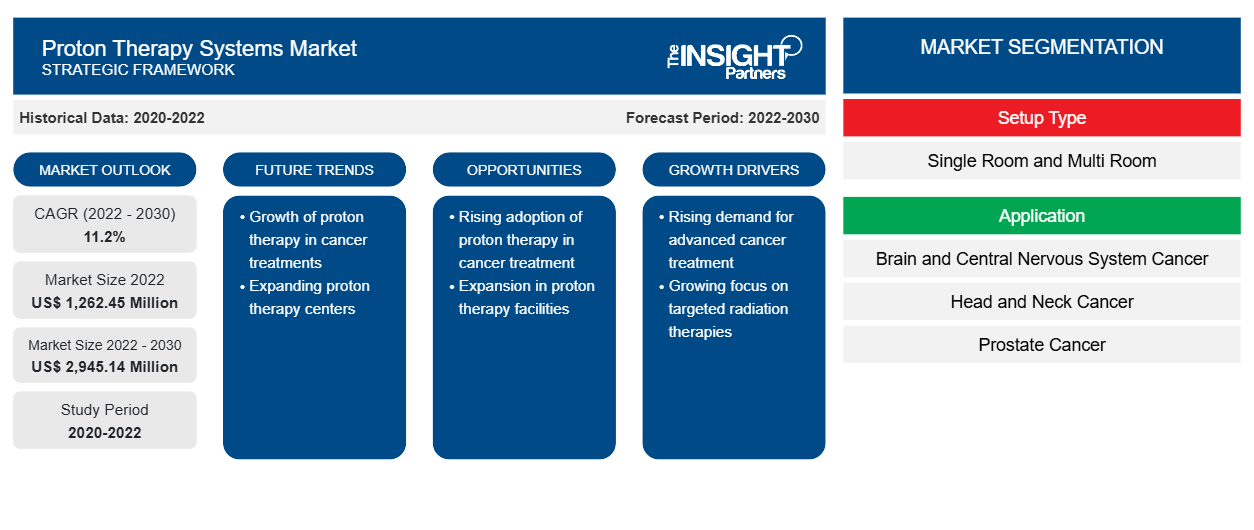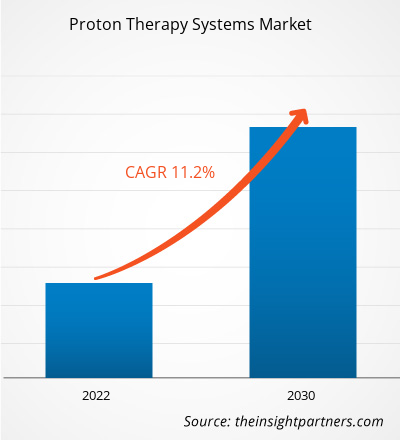[Informe de investigación] Se proyecta que el mercado de sistemas de terapia de protones crecerá de US$ 1.262,45 millones en 2022 a US$ 2.945,14 millones en 2030; se estima que registrará una CAGR del 11,2% durante 2022-2030.
Perspectivas del mercado y opinión de analistas:
El pronóstico del mercado de sistemas de terapia de protones puede ayudar a las partes interesadas en este mercado a delinear sus estrategias de crecimiento.
Un sistema de terapia de protones es un dispositivo médico avanzado que se emplea para proporcionar un tratamiento de radiación de alta precisión para tumores. Estos sistemas son de gran tamaño y constan de un acelerador (ciclotrón), un sistema de transporte de haz, un sistema de selección de energía y un equipo de irradiación de pórtico giratorio. Debido a su eficacia en el tratamiento de ciertos tipos de cáncer, ha habido una creciente demanda de terapia de protones en todo el mundo. Factores como la creciente demanda de tratamientos avanzados con el aumento de la incidencia del cáncer y el aumento del apoyo gubernamental a los centros de terapia de protones impulsan el crecimiento del mercado de sistemas de terapia de protones. Sin embargo, el alto costo y la gran superficie de los sistemas de terapia de protones obstaculizan el crecimiento del mercado. Además, se espera que la creciente adopción de enfoques de tratamiento personalizados con avances tecnológicos traiga nuevas tendencias al mercado de sistemas de terapia de protones en los próximos años.
Factores impulsores del crecimiento:
La creciente demanda de tratamientos avanzados y la creciente incidencia del cáncer impulsan el crecimiento del mercado
Según la Agencia Internacional para la Investigación sobre el Cáncer (IARC), los tipos de cáncer de pulmón, mama y próstata tuvieron la tasa de incidencia más alta en 2022. Estas enfermedades tienen una tasa estandarizada por edad de 23,6, 47,1 y 29,4 casos por cada 100.000 habitantes, respectivamente. Según las estimaciones de la IARC, se espera que el número total de casos de cáncer aumente de 19,98 millones en 2022 a 23,71 millones en 2030 y 30,97 millones en 2045. Varias afecciones cancerosas, como los cánceres de cabeza y cuello (nasal, oral, ocular y de laringe) y los cánceres cerebrales, tienen requisitos de tratamiento precisos, lo que da lugar a una gran demanda de enfoques de tratamiento avanzados como la terapia de protones de intensidad modulada (IMPT). En las radioterapias tradicionales, como la radioterapia con rayos X , el tejido sano alrededor del tumor también recibe una dosis de radiación, lo que provoca efectos secundarios y puede causar cánceres secundarios. Sin embargo, la terapia de protones ayuda al tratamiento eficaz de tumores complicados en el cerebro y la región de la cabeza y el cuello, al tiempo que minimiza el daño colateral a los tejidos cercanos. Por lo tanto, la alta prevalencia del cáncer y la demanda de tratamientos avanzados impulsan la demanda de radioterapia basada en protones, lo que impulsa el crecimiento del mercado de sistemas de terapia de protones.
Personalice este informe según sus necesidades
Obtendrá personalización en cualquier informe, sin cargo, incluidas partes de este informe o análisis a nivel de país, paquete de datos de Excel, así como también grandes ofertas y descuentos para empresas emergentes y universidades.
- Obtenga las principales tendencias clave del mercado de este informe.Esta muestra GRATUITA incluirá análisis de datos, desde tendencias del mercado hasta estimaciones y pronósticos.
Restricción:
Alto costo y gran área de los sistemas de terapia de protones
Un sistema de terapia de protones es un dispositivo médico avanzado que se utiliza en el tratamiento de radiación de alta precisión para tumores. Es un dispositivo médico enorme que consta de un acelerador (ciclotrón), un sistema de transporte del haz, un sistema de selección de energía y un equipo de irradiación de pórtico giratorio, lo que da como resultado grandes áreas de superficie y un alto costo del equipo. Según la Universidad de Pensilvania (Oncolink), los ciclotrones de los sistemas de terapia de protones pesan hasta 200 toneladas y tienen entre 6 y 12 pies de diámetro. El pórtico puede tener un peso de 100 toneladas y 40 pies de diámetro. Según un estudio publicado (2021) en IOPscience, incluso el diseño compacto (configuración de una sola habitación) implica un área de 100 metros cuadrados, mientras que los sistemas de terapia de protones de varias habitaciones ocupan entre 200 y 400 metros cuadrados de área.
Además, los sistemas de terapia de protones requieren una inversión de capital muy elevada. Por ejemplo, un sistema para una sola sala puede costar entre 30 y 50 millones de dólares. El costo de los sistemas de protones con múltiples pórticos puede partir de los 300 millones de dólares y, por lo general, se instalan solo en grandes hospitales y sistemas universitarios. Por lo tanto, los altos requisitos de inversión de capital y las grandes áreas de instalación son algunos de los factores que obstaculizan el crecimiento del mercado de sistemas de terapia de protones.
Segmentación y alcance del informe:
El análisis del mercado de sistemas de terapia de protones se ha realizado considerando los siguientes segmentos: tipo de configuración y aplicación.
Por tipo de configuración, el mercado se divide en sala individual y sala múltiple. El segmento de sala múltiple tuvo una mayor participación de mercado en sistemas de terapia de protones en 2022. Además, se prevé que el segmento de sala individual registre una CAGR más rápida durante el período de pronóstico.
El mercado, por aplicación, se clasifica en cáncer de cerebro y sistema nervioso central, cáncer de cabeza y cuello, cáncer de próstata, cáncer de mama, cáncer de pulmón , cáncer gastrointestinal y otros. El segmento de cáncer de cerebro y sistema nervioso central tuvo la mayor participación de mercado de sistemas de terapia de protones en 2022, y se anticipa que registre la CAGR más alta durante el período de pronóstico.
Análisis regional:
En términos geográficos, el alcance del informe de mercado de sistemas de terapia de protones incluye América del Norte, Europa, Asia Pacífico, América del Sur y Central, y Oriente Medio y África. En 2022, América del Norte representó la mayor participación de mercado.La creciente aceptación y adopción de los últimos dispositivos médicos, la alta prevalencia del cáncer y las innovaciones de productos por parte de actores clave contribuyen a la expansión del tamaño del mercado de sistemas de terapia de protones en América del Norte. Según las estimaciones de la Sociedad Estadounidense del Cáncer, EE. UU. registró ~1,95 millones de nuevos casos de cáncer y ~0,61 millones de muertes relacionadas con la enfermedad en 2023, lo que muestra un aumento significativo con respecto a los 1,60 millones de casos de cáncer y 0,60 millones de muertes notificadas en 2020. Según el Grupo Cooperativo de Terapia de Partículas, a fines de 2023, EE. UU. tenía el mayor número de sistemas de terapia de protones a nivel mundial, con 46 instalaciones de tratamiento de terapia de protones.
Perspectivas regionales del mercado de sistemas de terapia de protones
Los analistas de Insight Partners explicaron en detalle las tendencias y los factores regionales que influyen en el mercado de sistemas de terapia de protones durante el período de pronóstico. Esta sección también analiza los segmentos y la geografía del mercado de sistemas de terapia de protones en América del Norte, Europa, Asia Pacífico, Oriente Medio y África, y América del Sur y Central.

- Obtenga datos regionales específicos para el mercado de sistemas de terapia de protones
Alcance del informe de mercado de sistemas de terapia de protones
| Atributo del informe | Detalles |
|---|---|
| Tamaño del mercado en 2022 | US$ 1.262,45 millones |
| Tamaño del mercado en 2030 | US$ 2.945,14 millones |
| CAGR global (2022-2030) | 11,2% |
| Datos históricos | 2021-2022 |
| Período de pronóstico | 2022-2030 |
| Segmentos cubiertos | Por tipo de configuración
|
| Regiones y países cubiertos | América del norte
|
| Líderes del mercado y perfiles de empresas clave |
|
Densidad de actores del mercado de sistemas de terapia de protones: comprensión de su impacto en la dinámica empresarial
El mercado de sistemas de terapia de protones está creciendo rápidamente, impulsado por la creciente demanda de los usuarios finales debido a factores como la evolución de las preferencias de los consumidores, los avances tecnológicos y una mayor conciencia de los beneficios del producto. A medida que aumenta la demanda, las empresas amplían sus ofertas, innovan para satisfacer las necesidades de los consumidores y aprovechan las tendencias emergentes, lo que impulsa aún más el crecimiento del mercado.
La densidad de actores del mercado se refiere a la distribución de las empresas o firmas que operan dentro de un mercado o industria en particular. Indica cuántos competidores (actores del mercado) están presentes en un espacio de mercado determinado en relación con su tamaño o valor total de mercado.
Las principales empresas que operan en el mercado de sistemas de terapia de protones son:
- Sistemas médicos Varian Inc.
- Hitachi Ltd
- Sumitomo Heavy Industries Limited
- Aplicaciones de haces de iones SA
- Sistemas médicos Mevion
Descargo de responsabilidad : Las empresas enumeradas anteriormente no están clasificadas en ningún orden particular.

- Obtenga una descripción general de los principales actores clave del mercado de sistemas de terapia de protones
Desarrollos industriales y oportunidades futuras:
A continuación se enumeran algunos desarrollos estratégicos de los principales actores que operan en el mercado de sistemas de terapia de protones, según los comunicados de prensa de la empresa:
- En enero de 2024, OncoRay lanzó el prototipo de un sistema de terapia de protones guiado por resonancia magnética de cuerpo entero para el seguimiento en tiempo real de tumores en movimiento mediante imágenes por resonancia magnética (IRM) durante la terapia de protones. La IRM ayuda a visualizar los tumores con un contraste mejorado, lo que constituye su principal ventaja frente a las modalidades de imagen convencionales. Un mejor contraste permite delimitar mejor el tumor del tejido sano circundante y definir el volumen que se va a irradiar con mayor precisión.
- En diciembre de 2023, HKSH Medical Group inauguró un nuevo centro de terapia de protones en el HKSH Eastern Medical Centre en A Kung Ngam, Shau Kei Wan, Hong Kong. El nuevo centro cuenta con un sistema avanzado de terapia de protones y dos salas de tratamiento de última generación. El sistema incluye dos pórticos de terapia de protones semirrotativos, el último sistema de transporte de haz y un acelerador basado en sincrotrón.
Panorama competitivo y empresas clave:
Entre las empresas destacadas que aparecen en el informe de mercado de sistemas de terapia de protones se encuentran Varian Medical Systems Inc, Sumitomo Heavy Industries Ltd, Hitachi Ltd, Ion Beam Applications SA, Mevion Medical Systems, Provision Healthcare LLC, ProTom International, Optivus Proton Therapy Inc, Advanced Oncotherapy plc y B dot Medical Inc. Estas empresas se centran en el desarrollo de nuevas tecnologías, la actualización de los productos existentes y la expansión de su presencia geográfica para satisfacer la creciente demanda de los consumidores en todo el mundo.
- Análisis histórico (2 años), año base, pronóstico (7 años) con CAGR
- Análisis PEST y FODA
- Tamaño del mercado Valor/volumen: global, regional, nacional
- Industria y panorama competitivo
- Conjunto de datos de Excel



Report Coverage
Revenue forecast, Company Analysis, Industry landscape, Growth factors, and Trends

Segment Covered
This text is related
to segments covered.

Regional Scope
North America, Europe, Asia Pacific, Middle East & Africa, South & Central America

Country Scope
This text is related
to country scope.
Preguntas frecuentes
A proton therapy system is an advanced medical device employed to provide a highly precise radiation treatment for tumors. These systems are huge in size, and they consist of an accelerator (cyclotron), beam transport system, energy selection system, and rotating gantry irradiation equipment. Due to its effectiveness in treating certain types of cancer, there has been a growing demand for proton therapy worldwide.
Factors such as rising demand for advanced treatments with the surging cancer incidence, and increasing government support for proton therapy centers propel the proton therapy systems market growth. However, the high cost and large area of proton therapy systems hamper the growth of the market.
The proton therapy systems market is expected to be valued at US$ 2,945.14 million in 2030.
The proton therapy systems market majorly consists of the players, including Varian Medical Systems Inc, Sumitomo Heavy Industries Ltd, Hitachi Ltd, Ion Beam Applications SA, Mevion Medical Systems, Provision Healthcare LLC, ProTom International, Optivus Proton Therapy Inc, Advanced Oncotherapy plc, and B dot Medical Inc
By setup type, the market is bifurcated into single room and multi room. The multi room segment held a larger proton therapy systems market share in 2022. Further, the single room segment is anticipated to register a faster CAGR during the forecast period.
The proton therapy systems market was valued at US$ 1,262.45 million in 2022.
The market, by application, is categorized into brain and central nervous system cancer, head and neck cancer, prostate cancer, breast cancer, lung cancer, gastrointestinal cancer, and others. The brain and central nervous system cancer segment held the largest proton therapy systems market share in 2022, and it is anticipated to register the highest CAGR during the forecast period.
Trends and growth analysis reports related to Life Sciences : READ MORE..
The List of Companies - Proton Therapy Systems Market
- Varian Medical Systems Inc
- Hitachi Ltd
- Sumitomo Heavy Industries Limited
- Ion Beam Applications SA
- Mevion Medical Systems
- Provision Healthcare LLC
- ProTom International
- Optivus Proton Therapy Inc
- Advanced Oncotherapy plc
- B dot Medical Inc
The Insight Partners performs research in 4 major stages: Data Collection & Secondary Research, Primary Research, Data Analysis and Data Triangulation & Final Review.
- Data Collection and Secondary Research:
As a market research and consulting firm operating from a decade, we have published and advised several client across the globe. First step for any study will start with an assessment of currently available data and insights from existing reports. Further, historical and current market information is collected from Investor Presentations, Annual Reports, SEC Filings, etc., and other information related to company’s performance and market positioning are gathered from Paid Databases (Factiva, Hoovers, and Reuters) and various other publications available in public domain.
Several associations trade associates, technical forums, institutes, societies and organization are accessed to gain technical as well as market related insights through their publications such as research papers, blogs and press releases related to the studies are referred to get cues about the market. Further, white papers, journals, magazines, and other news articles published in last 3 years are scrutinized and analyzed to understand the current market trends.
- Primary Research:
The primarily interview analysis comprise of data obtained from industry participants interview and answers to survey questions gathered by in-house primary team.
For primary research, interviews are conducted with industry experts/CEOs/Marketing Managers/VPs/Subject Matter Experts from both demand and supply side to get a 360-degree view of the market. The primary team conducts several interviews based on the complexity of the markets to understand the various market trends and dynamics which makes research more credible and precise.
A typical research interview fulfils the following functions:
- Provides first-hand information on the market size, market trends, growth trends, competitive landscape, and outlook
- Validates and strengthens in-house secondary research findings
- Develops the analysis team’s expertise and market understanding
Primary research involves email interactions and telephone interviews for each market, category, segment, and sub-segment across geographies. The participants who typically take part in such a process include, but are not limited to:
- Industry participants: VPs, business development managers, market intelligence managers and national sales managers
- Outside experts: Valuation experts, research analysts and key opinion leaders specializing in the electronics and semiconductor industry.
Below is the breakup of our primary respondents by company, designation, and region:

Once we receive the confirmation from primary research sources or primary respondents, we finalize the base year market estimation and forecast the data as per the macroeconomic and microeconomic factors assessed during data collection.
- Data Analysis:
Once data is validated through both secondary as well as primary respondents, we finalize the market estimations by hypothesis formulation and factor analysis at regional and country level.
- Macro-Economic Factor Analysis:
We analyse macroeconomic indicators such the gross domestic product (GDP), increase in the demand for goods and services across industries, technological advancement, regional economic growth, governmental policies, the influence of COVID-19, PEST analysis, and other aspects. This analysis aids in setting benchmarks for various nations/regions and approximating market splits. Additionally, the general trend of the aforementioned components aid in determining the market's development possibilities.
- Country Level Data:
Various factors that are especially aligned to the country are taken into account to determine the market size for a certain area and country, including the presence of vendors, such as headquarters and offices, the country's GDP, demand patterns, and industry growth. To comprehend the market dynamics for the nation, a number of growth variables, inhibitors, application areas, and current market trends are researched. The aforementioned elements aid in determining the country's overall market's growth potential.
- Company Profile:
The “Table of Contents” is formulated by listing and analyzing more than 25 - 30 companies operating in the market ecosystem across geographies. However, we profile only 10 companies as a standard practice in our syndicate reports. These 10 companies comprise leading, emerging, and regional players. Nonetheless, our analysis is not restricted to the 10 listed companies, we also analyze other companies present in the market to develop a holistic view and understand the prevailing trends. The “Company Profiles” section in the report covers key facts, business description, products & services, financial information, SWOT analysis, and key developments. The financial information presented is extracted from the annual reports and official documents of the publicly listed companies. Upon collecting the information for the sections of respective companies, we verify them via various primary sources and then compile the data in respective company profiles. The company level information helps us in deriving the base number as well as in forecasting the market size.
- Developing Base Number:
Aggregation of sales statistics (2020-2022) and macro-economic factor, and other secondary and primary research insights are utilized to arrive at base number and related market shares for 2022. The data gaps are identified in this step and relevant market data is analyzed, collected from paid primary interviews or databases. On finalizing the base year market size, forecasts are developed on the basis of macro-economic, industry and market growth factors and company level analysis.
- Data Triangulation and Final Review:
The market findings and base year market size calculations are validated from supply as well as demand side. Demand side validations are based on macro-economic factor analysis and benchmarks for respective regions and countries. In case of supply side validations, revenues of major companies are estimated (in case not available) based on industry benchmark, approximate number of employees, product portfolio, and primary interviews revenues are gathered. Further revenue from target product/service segment is assessed to avoid overshooting of market statistics. In case of heavy deviations between supply and demand side values, all thes steps are repeated to achieve synchronization.
We follow an iterative model, wherein we share our research findings with Subject Matter Experts (SME’s) and Key Opinion Leaders (KOLs) until consensus view of the market is not formulated – this model negates any drastic deviation in the opinions of experts. Only validated and universally acceptable research findings are quoted in our reports.
We have important check points that we use to validate our research findings – which we call – data triangulation, where we validate the information, we generate from secondary sources with primary interviews and then we re-validate with our internal data bases and Subject matter experts. This comprehensive model enables us to deliver high quality, reliable data in shortest possible time.


 Obtenga una muestra gratuita de este informe
Obtenga una muestra gratuita de este informe